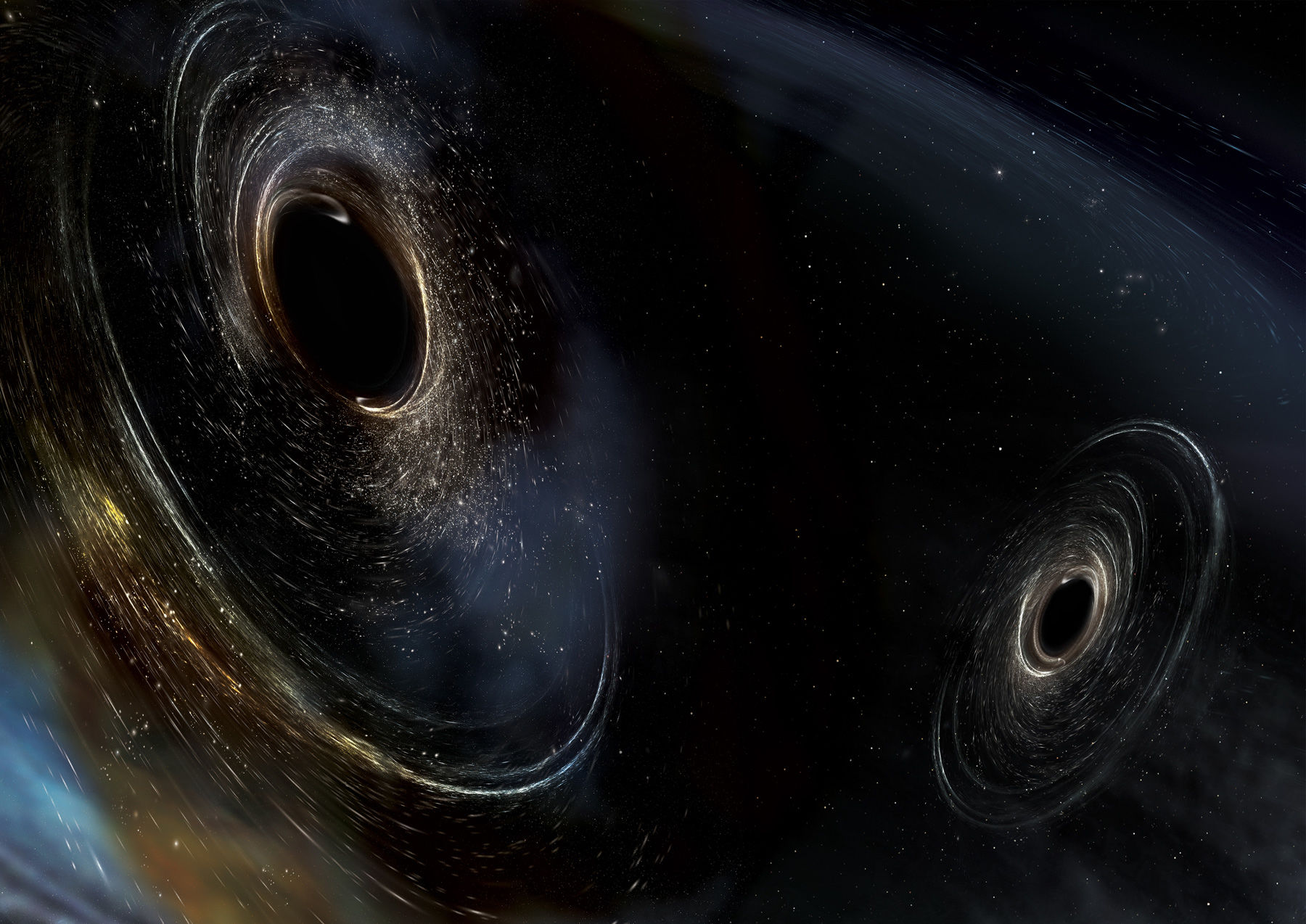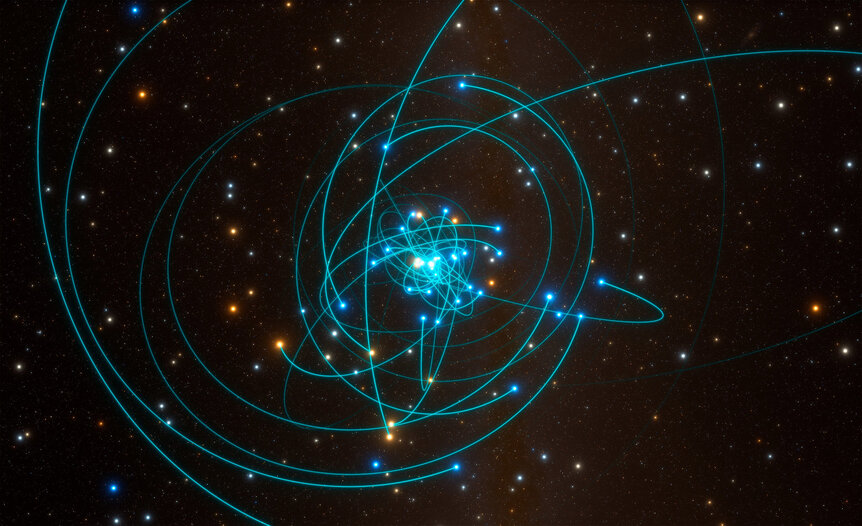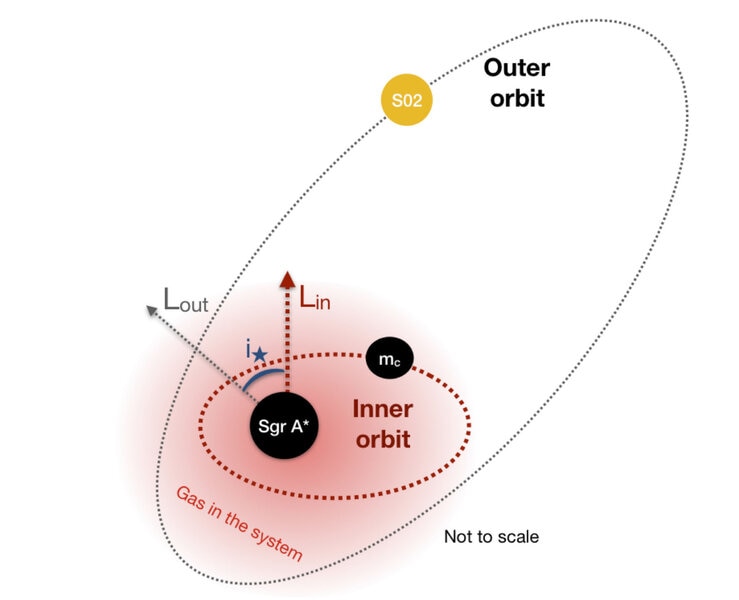Create a free profile to get unlimited access to exclusive videos, sweepstakes, and more!
Does our galaxy's huge black hole have a little black hole buddy?

In the center of our galaxy lies a huge black hole, so big we call it supermassive: It has the mass of four million times our Sun's. Called Sgr A* (literally spoken as "Sagittarius A star," or "Saj A star"), the evidence for it is overwhelming; we can see stars orbiting it, their positions changing over the course of years and in some cases months. The math of orbital mechanics tell us they are enthralled to an object with several million times the mass of a star, but if there were that many stars there they'd glow with fierce light. We see essentially nothing, so a black hole it must be.
But… is it alone? Could there be a second black hole there, one less massive but still dizzyingly hefty, orbiting Sgr A* closely?
There's reason to think there could be. Big galaxies like ours grow over the eons in many ways, but one big one is to eat other galaxies. If two galaxies get too close, their mutual gravity can draw them together until they collide and eventually merge. We know that most big (and many small) galaxies have supermassive black holes in their centers, too, so over time that second galaxy's black hole would fall to the center of our galaxy, and could settle into a tight orbit around it.
We know that the Milky Way has eaten many galaxies, including a decent sized one a couple of billion years ago. If that's the case, and there's another black hole in our galaxy's heart, how could we tell?
A team of astronomers tackled this question in a recent paper. Seeing this second (or companion) black hole directly is probably impossible, but the effects it would have on the region around our primary black hole could be detectable. They set about looking to see what these might be.
One effect would be on the orbits of the stars near Sgr A*, another would be on the matter (gas and dust) orbiting Sgr A* very close in, and a third would be on the emission of gravitational waves. So what did they find?
There is a cluster of massive, luminous stars orbiting Sgr A*, called collectively S stars.
One of these, S2 (or sometimes S02), has an orbit just 16 years long. The orbit is an ellipse, dropping it down to a mere 16 billion kilometers from the black hole, close enough that it screams by at 2% the speed of light! Observations of the star's movement over time have constrained its orbit pretty well, so we have a decent grasp of its shape.
That makes it a pretty good canary in the coal mine for the existence of a second black hole. If that black hole is too massive, or orbits Sgr A* far enough out, its gravity would affect the orbit of S2 so severely that it would become unstable over short timescales — the star would either get tossed away from the center, or fall into Sgr A*. Since we think the orbit is stable, that provides upper limits to how massive a second black hole can be, and how far it can get from Sgr A*. More subtly, over time the black hole can affect the shape and orientation of S2's orbit that we could observe, and if we assume that hasn't happened then we can say things about that black hole.
A lot of this depends on the orientation of the orbits, too. The research done assumes the star's orbit is tilted with respect to the orbits of the two black holes around each other. Interestingly, this allows the second black hole to be more massive and get farther from Sgr A* than if the star orbited in the plane; because the star's orbit is tilted it can get closer to Sgr A* than the second black hole! If they were all in the same plane that couldn't happen, since the orbit of the star might intersect that of the black hole, and a very close encounter would happen pretty quickly, and that wouldn't end well for the star.
So what did they find? For example, if the second black hole is pretty beefy — say, 100,000 times the mass of the Sun — and has a circular orbit, then it cannot be more than about 25 billion kilometers from Sgr A* without severely affecting the orbit of S2 in a noticeable way. If it has less mass, say ten thousand Suns, it can be have a circular orbit much farther out, about 60 billion km, before it starts to perturb S2.
This gets complicated fast, since the mass of the second black hole and the distance and shape of its orbit all interplay. But the overall point is that we can set limits to its characteristics, and that by itself is interesting.
But can we see its effects? There is a disk of material, gas and dust, circling Sgr A* very close in. Called an accretion disk, it's very hot and emits light we can detect from Earth. This emission is not constant, but in some wavelengths like infrared the brightness changes on timescales as rapidly as hours and even minutes! The reason for this isn't known… but a second black hole on an elliptical orbit could dip down close enough to this accretion disk to affect it, perhaps even eating some of the material itself (which might explain flares in brightness seen recently). The new research shows that if the second black hole orbits closely enough, it could produce the variations in brightness seen in the infrared.
Cool. This isn't proof it's there so much as "proof of concept," meaning the numbers aren't too ridiculous. If there's a second black hole there then under some circumstances it could explain the brightness variations. Still, that's neat.
Finally they looked at gravitational waves. When two very massive objects orbit each other closely, they literally send out ripples in the fabric of spacetime. This is a prediction of general relativity, and we've seen this happen as neutron stars and black holes orbit each other and even merge together, creating quite a large bang. Running the numbers, they find that the gravitational waves emanating from a purported second black hole couldn't be detected with current technology. However, the European Space Agency has a proposed mission called LISA (Laser Interferometer Space Array) that could see these waves! LISA is being planned right now and could launch as soon as 2034. If so, and things work out well, we may not have to wait more than 15 years or so before a second black hole is found.
On the other hand, another star with an even closer orbit than S2 was recently found, and it might put tighter constraints on a second black holes' properties. The orbit isn't as well understood (it's fainter, and harder to pick out against background noise in images), but it's possible in time it might tighten things up.
It wasn't that long ago that we knew very little about the central few hundred billion kilometers of our galaxy, but that's changed. We see stars there, gas, dust, disks of material, and maybe, possibly, sometime soon we'll find out if a second monster lives there, too. Well, a mini-monster. And if we don't see it, we'll still be learning more about this crowded, bizarre volume of space around which our galaxy spins.





























